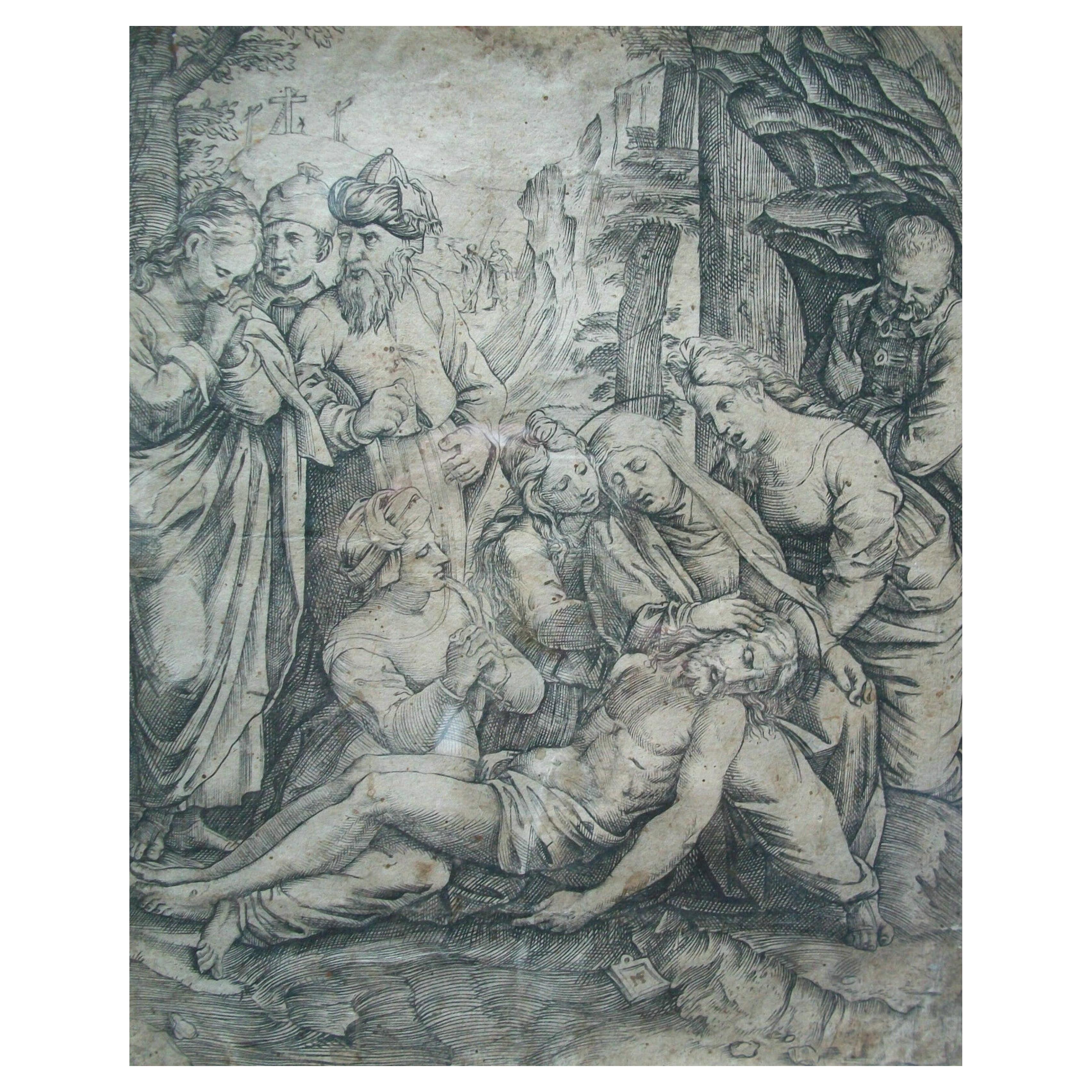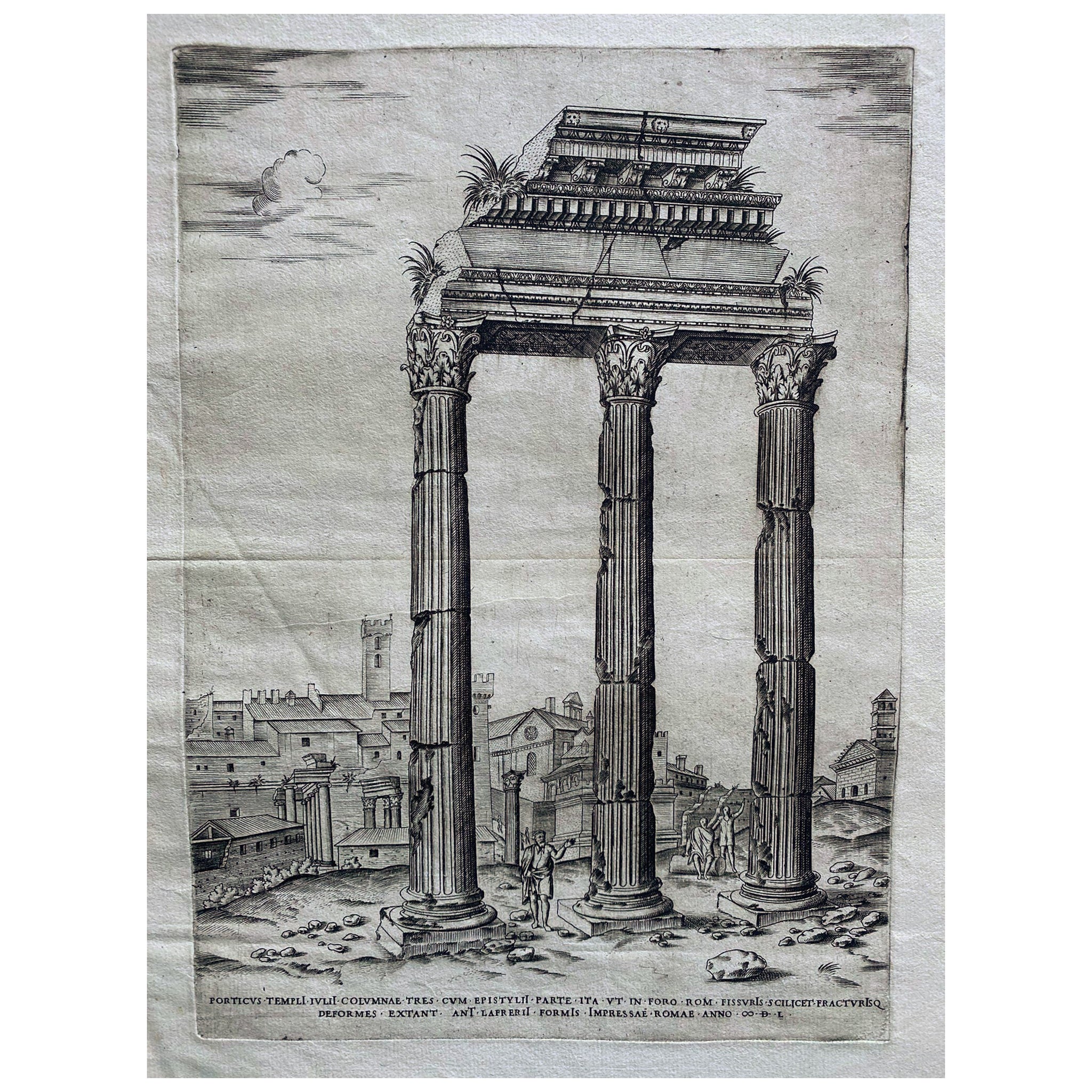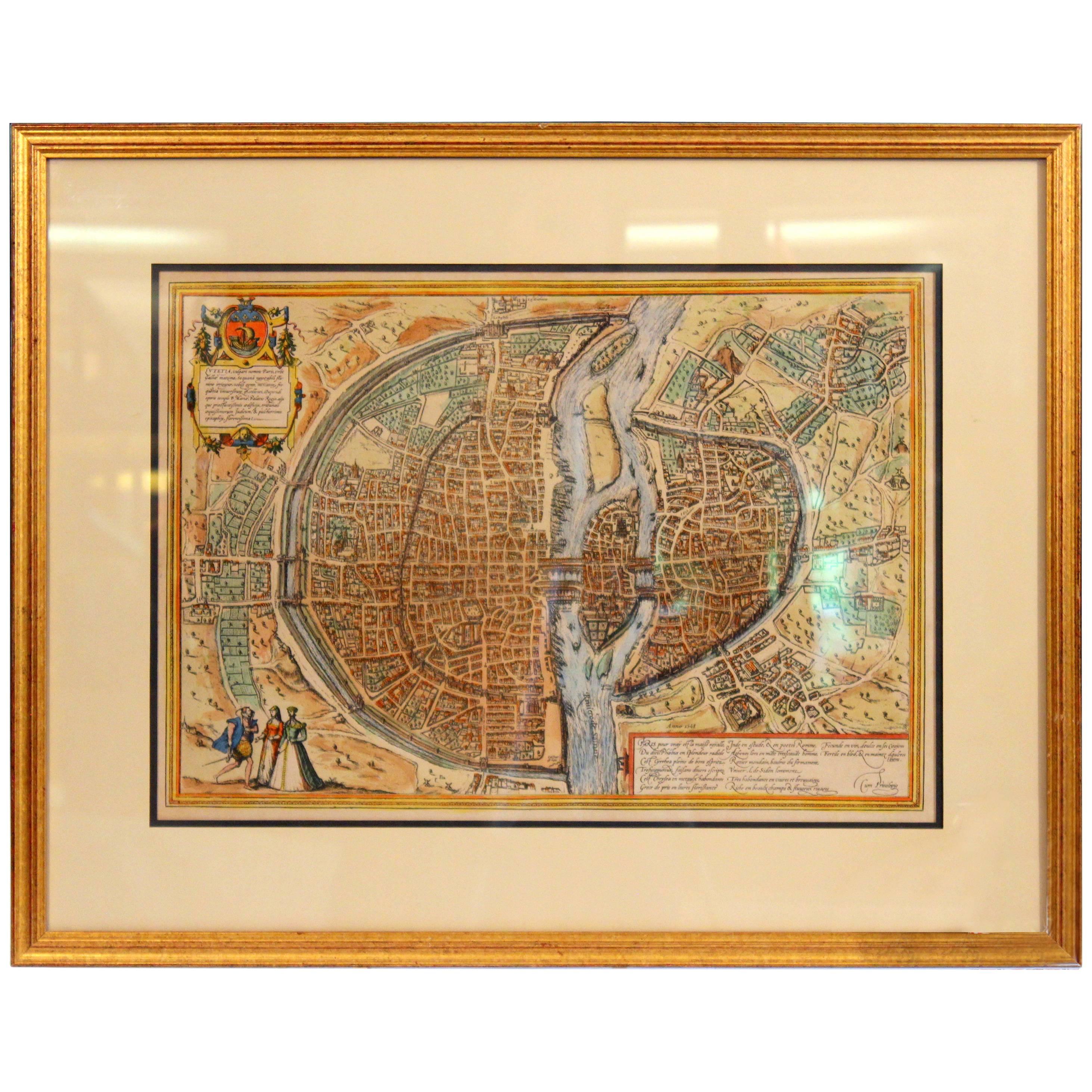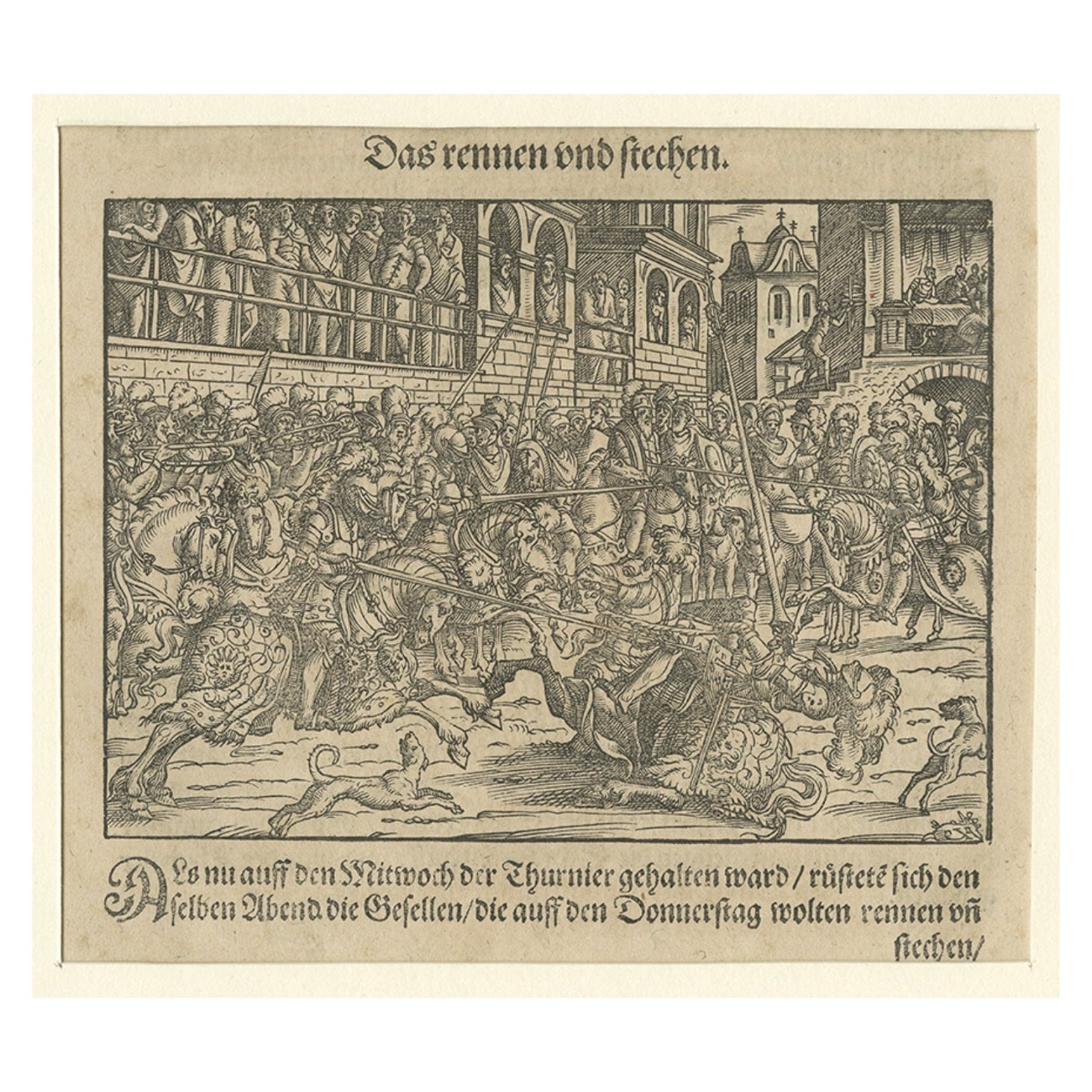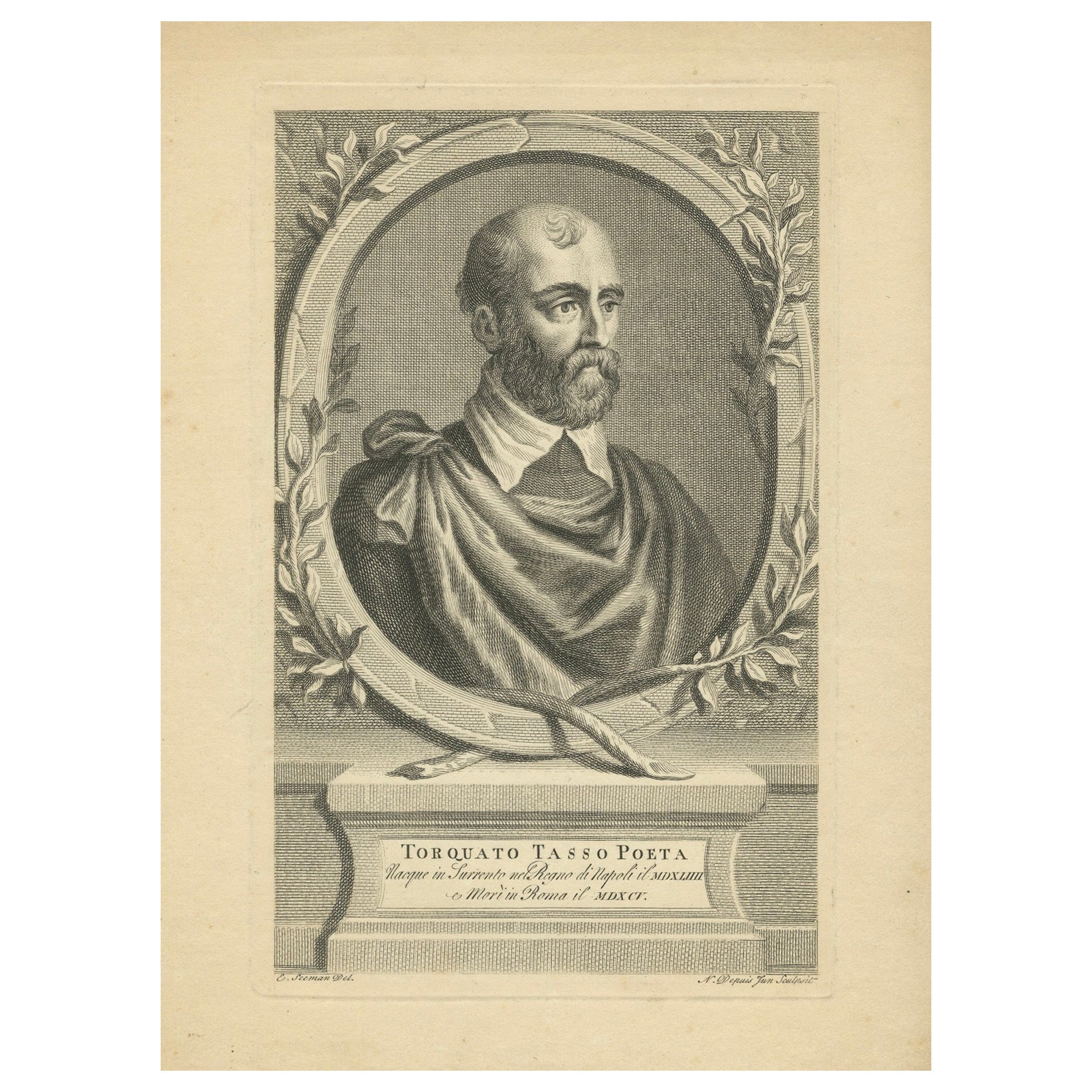Items Similar to 16th Century School of Fontainebleau Engraving
Want more images or videos?
Request additional images or videos from the seller
1 of 5
16th Century School of Fontainebleau Engraving
About the Item
This 16th century French engraving illustrates an episode in the Trojan War – although the actual one illustrated is in question. According to recent scholarship, it depicts the corpse the hoary Trojan warrior Hector being carried into the walled city of Troy. But according to tradition, it depicts the wounded Trojan princeling Paris (who started the war) being carried back in. Favoring the former interpretation is that the episode appears in Homer’s Iliad. Favoring the later is that the comely young man seems very much alive.
The scene is presented theatrically. Feet scuffle along the edge of a stage, and the leading man looks at us with bedroom eyes through tousled locks. Dead or alive, his dead weight is shouldered by a warrior with an improbably balletic lift of leg -- one that should send both crashing to the ground. Such archness is typical of Mannerism, or the late Renaissance.
In any case, the print bears the engraver’s initials “GR.F”, and the inscription “a Fontana.Bleo. Bol.”, which a 16th century viewer would take to mean that the image depicted was painted “at Fontainebleau,” after the work of the “Bolognese” painter Francesco Primaticcio, the Italian artist from that Italian city, who found fame and fortune at the court of Fountainebleau, the seat of King Francis I of France.
Francis summoned Primaticcio there in 1534. Between 1541 and 1544 the artist frescoed the barrel-vaulted ceiling of the Porte Dorée, the ceremonial entrance to palace’s courtyard, where he painted this scene, and a few others, including Hercules being dressed as a woman (the taste at court was nothing if not kinky). All of the scenes conformed to an obscure iconographic program that promoted the king, and celebrating his reign. Not incidentally, at the time, a legend gained traction that Frankus, a mythological warrior, had established the French kingdom after fleeing fallen Troy.
Who engraved Primaticcio’s scene is a mystery. In the 19th century a group of stylistically related prints, bearing the initials R G F, were identified as the work of an engraver who was then christened Master F. G. It was posited that he may have been Francois Gentil, a Frenchman who worked at Fontainebleau, and to whom no paintings or drawings could be attributed. Then it was pointed out that the F isn’t an initial but an abbreviation for fecit, which is Latin for “he made it.” That would suggest his initials were G R. Then it was posited that he was Guido Ruggieri, an Italian who also worked there, and to whom no other works could be attributed. And so the jury remains out, on both the subject of the print, and the identity of the engraver.
- Creator:Master F.G. (Artist)
- Dimensions:Height: 12.5 in (31.75 cm)Width: 17.5 in (44.45 cm)Depth: 2 in (5.08 cm)
- Style:Renaissance (Of the Period)
- Materials and Techniques:
- Place of Origin:
- Period:
- Date of Manufacture:circa 1550
- Condition:Wear consistent with age and use.
- Seller Location:New York, NY
- Reference Number:1stDibs: LU1061422878072
About the Seller
5.0
Recognized Seller
These prestigious sellers are industry leaders and represent the highest echelon for item quality and design.
Established in 1994
1stDibs seller since 2014
19 sales on 1stDibs
- ShippingRetrieving quote...Ships From: New York, NY
- Return PolicyThis item cannot be returned.
More From This SellerView All
- Misia Sert's Bookplate by Pierre BonnardBy Pierre BonnardLocated in New York, NYMisia Sert, a musical prodigy who once played the piano on Franz List’s knee, grew up to be a beauty, and remained the apogee of chic until she died at seve...Category
Vintage 1910s French Modern Prints
MaterialsPaper
- Japanese Color Woodblock Print by Toyohara ChikanobuBy Toyohara ChikanobuLocated in New York, NYThis Meiji-period color woodblock by Toyohara Chikanobu (1838-1912) depicts three elegant female courtiers in traditional dress taking refreshments. Th...Category
Antique Late 19th Century Japanese Meiji Prints
MaterialsPaper
- Paul Poiret's Two Editions de LuxeBy Paul PoiretLocated in New York, NYPaul Poiret's career began in the Belle Epoque, when fashion was defined by imprisoning corsets, restrictive tailoring, and ethereal colors. Opening his own fashion house in 1904, he...Category
Antique Early 1900s French Art Deco Books
MaterialsPaper
- Pair of 18th Century Italian ArmchairsLocated in New York, NYLow, deep, and wide, this pair of armchairs is exceptionally comfortable, and the gold and black color scheme is very dramatic. What’s most distinctive about them from a design point...Category
Antique 1790s Italian Neoclassical Armchairs
MaterialsWool, Wood
- Pair of 18th-Century Italian Console TablesLocated in New York, NYThis pair of Italian Neo-Classical console tables were carved, painted battleship-grey, gilded, and topped with slabs of Carrara marble. Each has a carved cartouche — one with a pair...Category
Antique Late 18th Century Italian Neoclassical Credenzas
MaterialsMarble
- 18th Century Giltwood Sculpture of a Female NudeBy Michelangelo BuonarrotiLocated in New York, NYThis giltwood sculpture was carved in the round, probably in southern France or northern Italy in the 1760s. Her pronounced musculature speaks to the ongoing influence of Michelange...Category
Antique Mid-18th Century French Neoclassical Mounted Objects
MaterialsBronze
You May Also Like
- Marcantonio Raimondi 'Pupil of, Antique Engraving, Italy, Mid-16th CenturyLocated in Chatham, ONA very rare - finest quality - mid 16th century Italian Renaissance engraving (after Raphael) by an anonymous pupil of MARCANTONIO RAIMONDI (1480-...Category
Antique 16th Century Italian Renaissance Prints
MaterialsPaper
- Antoine Lafrery Set of 6 Engraving "Speculun Romanae Magnificen" 16th CenturyLocated in Beuzevillette, FRBeautiful and very rare set of six engravings extracted from the work entitled “speculun romanae superbeiae” produced between 1554 and 1573 by An...Category
Antique 16th Century Italian Renaissance Picture Frames
MaterialsPaper
- Old Engraving Map of Paris French Munster 16th Century Walled City FramedLocated in Wilton, CTOld or antique colored engraving of Munster's 1572 map of Paris, circa 19th or 20th century (Frame was not opened to look for a publication ...Category
20th Century French Renaissance Prints
MaterialsPaper
- Original 16th Century Engraving of a Medieval Tournament, ca.1578Located in Langweer, NLAntique print titled 'Das rennen und stechen'. Engraving of a Medieval tournament. This print originates from 'Thurnier Buch. Von Anfang, Ursachen, ursprung und herkommen (..)' b...Category
Antique 16th Century Prints
MaterialsPaper
- Original Hand-Colored Engraving of a 16th Century German Nobleman, 1805Located in Langweer, NLAntique costume print titled 'Deutscher Edelmann - Noble Allemand en 1577'. This print depicts a German nobleman. Originates from a rare costume book ...Category
Antique Early 1800s Prints
MaterialsPaper
- Engraving of Torquato Tasso, Prominent Italian Poet of the 16th century, 1724Located in Langweer, NLAn engraving of Torquato Tasso, a prominent Italian poet of the 16th century, best known for his epic poem "Gerusalemme Liberata" ("Jerusalem Delivered"), which tells the story of th...Category
Antique 1720s Prints
MaterialsPaper
Recently Viewed
View AllMore Ways To Browse
G Engraved Initial
19th Century Barrel Back
Homer Iliad
1550 Paintings
Trojan War
King Francois I
Antique Ceremonial Dress
The Iliad
Engraving Of Hercules
Guido F
Andre The Giant
Antique Cecil Aldin Signed Print
Antique Planisphere
Astronomy Wall Chart
Athanasius Kircher
Barbary Lion
Coconut Spoon
Dame Elisabeth Frink
